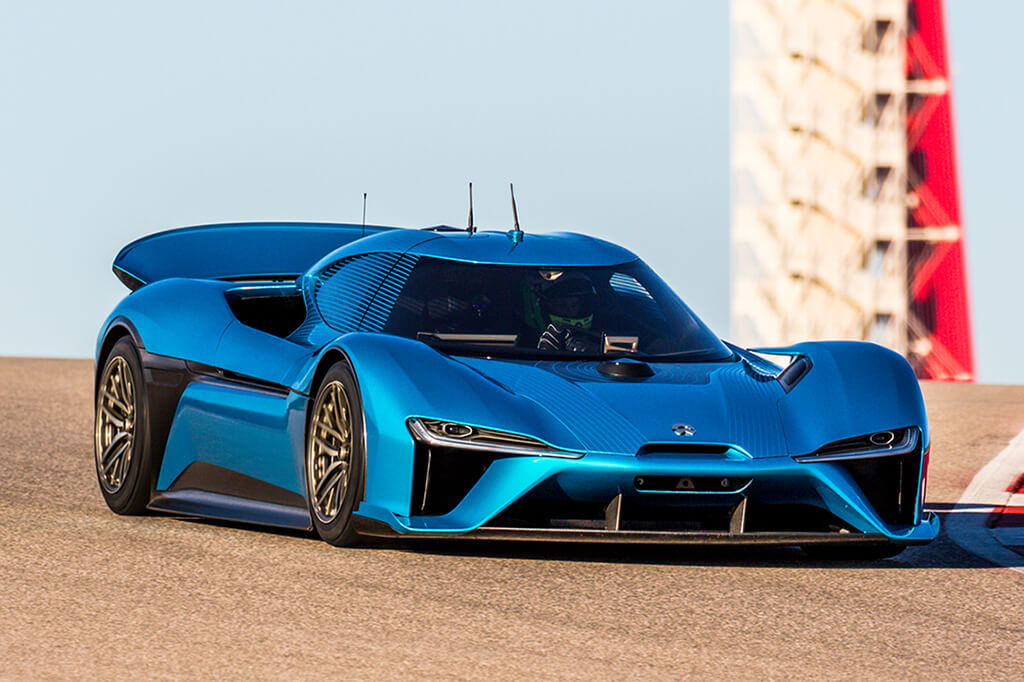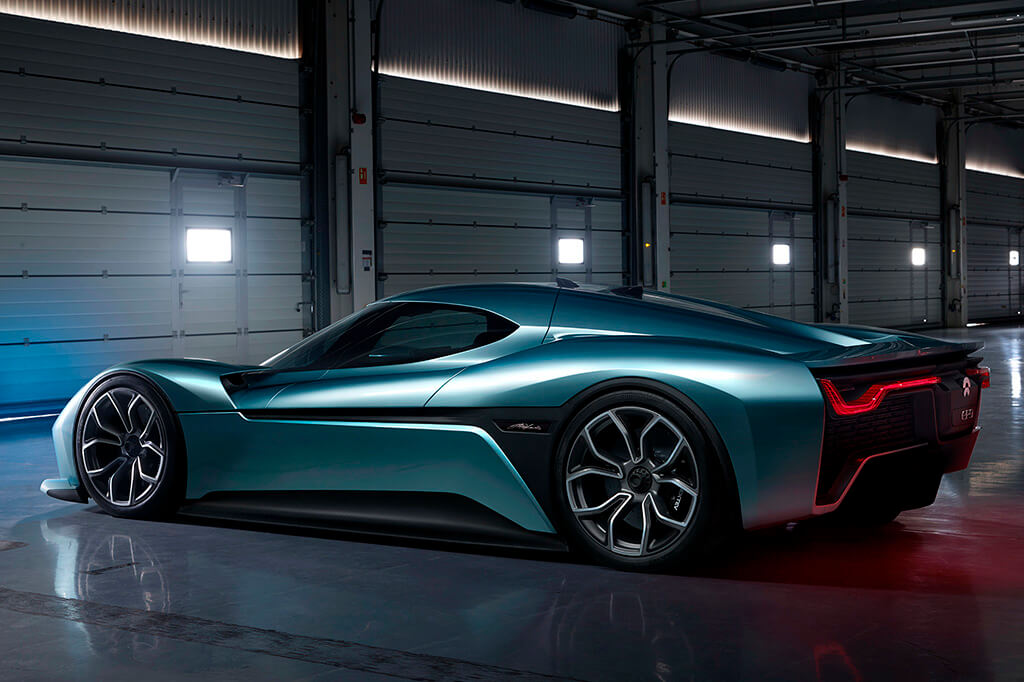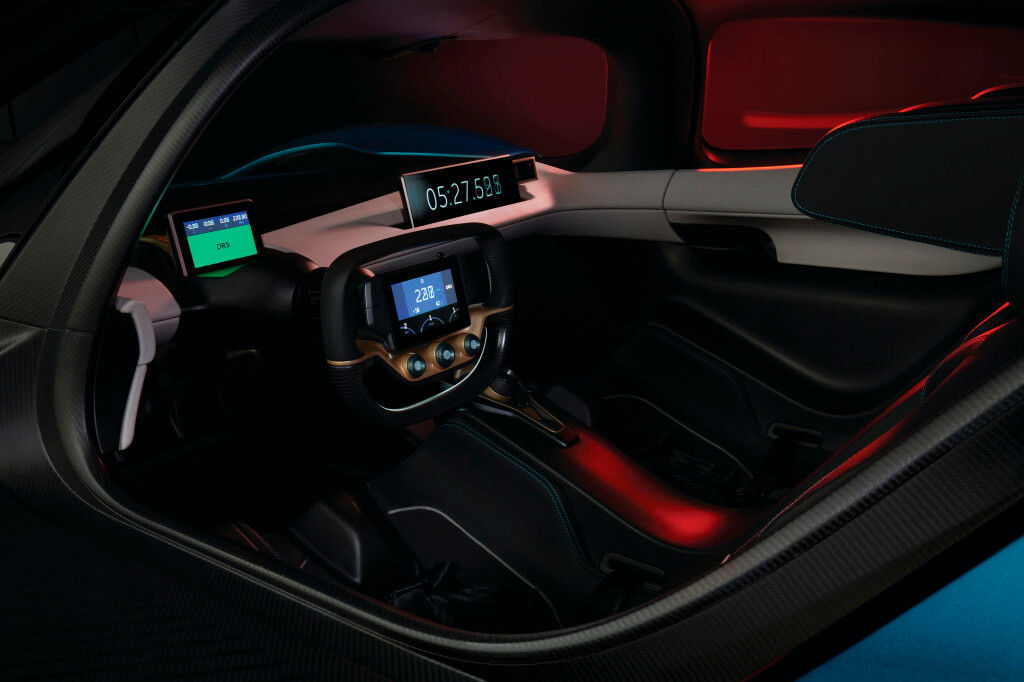NIO EP9
Description
The NIO EP9 is a Chinese two-seater electric powered sports car produced by NIO with support from the Formula E racing division. The name EP9 stands for Electric Performance 9.
EP9 was developed in just 18 months and was presented to the public at the Saatchi Gallery in London in November 2016. Production started in 2017. The lead designer for EP9 was David Hilton, who was also NIO's senior design director.
The supercar was not intended for road use, and set several records on the race track.
Each EP9 wheel received its own engine and transmission with a gear ratio of 1:4.283. Each engine was rated at 250 kW (335.25 hp), giving the car a total power output of 1 MW (1,360 hp). The EP9 could be driven either in four-wheel drive mode or by directly selecting the drive wheels, which was supported by an advanced torque vectoring system that could adjust the power output to each wheel.
The EP9 could accelerate from 0 to 100 kph in 2.7 seconds, to 200 kph in 7.1 seconds and to 300 kph in 15.9 seconds. The car could reach a top speed of 350 kph, but it was set at 313 kph.
The energy was stored in two lithium-ion batteries of 45 kWh each, which took approximately 45 minutes to charge. They were installed on the sides of the car. They could be removed and installed in 8 minutes. The batteries were liquid cooled and operated at 777 V DC. A full battery charge lasted for 427 km.
The EP9 was equipped with an active wheel suspension with a ride height controller that made 200 calculations per second. Tires were offered to choose from: slick tires measuring 320/705 R19 or road tires 295/35 R21.
The braking system was developed by NextEV and consisted of 6-piston calipers and ceramic brake discs measuring 408×40 mm on the front axle and 408×36 mm on the rear.
The supercar body was built “around” a carbon fiber monocoque, which weighed only 165 kilos and had a torsional rigidity of up to 30,000 Nm/deg. All carbon fiber components weighed 364 kg, the battery weighed 635 kg, and the curb weight of the entire supercar was 1735 kg.
The car's chassis design complied with FIA Le Mans Prototype regulations.
Instead of the usual doors, “half doors” were installed that open upward. The rear wing could be adjusted to three positions: park position, low downforce and high downforce. At 240 km/h the downforce was 24.47 kilonewtons, 200 percent more than a Formula 1 racing car.
Like the body and chassis, the interior was also made of carbon fiber. Each bucket seat is made from carbon fiber and trimmed in leather.
There were four monitors in the cabin: one in the driver's and front passenger's field of view, one in the console between the two seats, and one on the steering wheel. The monitors in front of the driver and front passenger showed performance data, but operated differently. On the passenger side, only four values were displayed: speed, lap time, lateral acceleration in G and the driver's heart rate. A monitor on the center console showed performance data and lap times, as well as a route map showing the car's current position. The steering wheel monitor was a simplified version of the steering wheel used in the NextEV Formula E.
NextEV was going to assemble a total of 16 units. Six of them were reserved for their own investors, and an additional 10 were made to order. The price was not announced, but the creators claimed that the construction of one supercar cost $1.2 million.
Sources
Specification
| Bodywork | |
|---|---|
| Presentation | |
| Years of production |
2017-
|
| Produced (pcs.) |
16
|
| Body type |
купе
|
| Number of doors |
2
|
| Number of places |
2
|
| Engine | |
|---|---|
| Engine type |
электрический (BEV)
|
| Number of electric motors |
4
|
| Cooling |
жидкостное
|
| Power output (hp / kW /) |
1360 /
1000 /
|
| Torque (N•m) |
1382
|
| Battery Type |
Li-ion
|
| Battery capacity (kWh) |
90
|
| Battery voltage (V) |
777
|
| Battery weight (kg) |
635
|
| Specific | |
|---|---|
| Specific output (hp/tonne) |
783,86
|
| Specific output (kg/hp) |
1,28
|
| Specific torque (N•m/tonne) |
796,54
|
| Transmission | |
|---|---|
| Driven wheels |
полный
|
| Suspension | |
|---|---|
| Front suspension |
независимая на двойных поперечных рычагах
|
| Rear suspension |
независимая на двойных поперечных рычагах
|
| Elastic elements in front |
пружины
|
| Elastic elements in rear |
пружины
|
| Front anti-roll bar | |
| Rear anti-roll bar | |
| Wheel size front |
10,5J×21
|
| Wheel size rear |
10,5J×21
|
| Tyres front |
295/35 R21
|
| Tyres rear |
295/35 R21
|
| Steering | |
|---|---|
| Steering type |
шестерня-рейка
|
| Power steering |
да
|
| Brakes specs | |
|---|---|
| Brakes front |
дисковые вентилируемые
|
| Brakes rear |
дисковые вентилируемые
|
| Front brake diameter (mm) |
408×40
|
| Rear brake diameter (mm) |
408×36
|
| Disc material |
карбон-керамика
|
| Brand of brakes |
NextEV
|
| Number of caliper pistons (front/rear) |
6
|
| Anti-lock braking system |
да
|
| Dimensions and weight | |
|---|---|
| Body |
монокок с панелями
|
| Body material |
углеволокно
|
| Body weight (kg) |
364
|
| Torsional rigidity (N·m/deg) |
30000
|
| Length (mm) |
4888
|
| Width (mm) |
2230
|
| Height (mm) |
1150
|
| Curb weight (kg) |
1735
|
| Performance specs | |
|---|---|
| Range (CLTC) (km) |
427
|
| Dynamic specs | |
|---|---|
| Acceleration 0-10 kph (s) |
0,3
|
| Acceleration 0-20 kph (s) |
0,5
|
| Acceleration 0-30 kph (s) |
0,8
|
| Acceleration 0-40 kph (s) |
1,0
|
| Acceleration 0-50 kph (s) |
1,2
|
| Acceleration 0-60 kph (s) |
1,5
|
| Acceleration 0-70 kph (s) |
1,8
|
| Acceleration 0-80 kph (s) |
2,1
|
| Acceleration 0-90 kph (s) |
2,4
|
| Acceleration 0-100 kph (s) |
2,7
|
| Acceleration 0-110 kph (s) |
3,1
|
| Acceleration 0-120 kph (s) |
3,4
|
| Acceleration 0-130 kph (s) |
3,8
|
| Acceleration 0-140 kph (s) |
4,1
|
| Acceleration 0-150 kph (s) |
4,5
|
| Acceleration 0-160 kph (s) |
4,9
|
| Acceleration 0-170 kph (s) |
5,4
|
| Acceleration 0-180 kph (s) |
5,9
|
| Acceleration 0-190 kph (s) |
6,5
|
| Acceleration 0-200 kph (s) |
7,1
|
| Acceleration 0-210 kph (s) |
7,8
|
| Acceleration 0-220 kph (s) |
8,7
|
| Acceleration 0-230 kph (s) |
9,7
|
| Acceleration 0-240 kph (s) |
10,7
|
| Acceleration 0-250 kph (s) |
11,8
|
| Acceleration 0-260 kph (s) |
12,8
|
| Acceleration 0-270 kph (s) |
13,8
|
| Acceleration 0-280 kph (s) |
14,6
|
| Acceleration 0-290 kph (s) |
15,4
|
| Acceleration 0-300 kph (s) |
15,9
|
| Acceleration 0-10 mph (s) |
0,4
|
|---|---|
| Acceleration 0-20 mph (s) |
0,8
|
| Acceleration 0-30 mph (s) |
1,2
|
| Acceleration 0-40 mph (s) |
1,6
|
| Acceleration 0-50 mph (s) |
2,1
|
| Acceleration 0-60 mph (s) |
2,6
|
| Acceleration 0-70 mph (s) |
3,1
|
| Acceleration 0-80 mph (s) |
3,7
|
| Acceleration 0-90 mph (s) |
4,3
|
| Acceleration 0-100 mph (s) |
5,0
|
| Acceleration 0-110 mph (s) |
5,8
|
| Acceleration 0-120 mph (s) |
6,7
|
| Acceleration 0-130 mph (s) |
7,8
|
| Acceleration 0-140 mph (s) |
9,2
|
| Acceleration 0-150 mph (s) |
10,9
|
| Acceleration 0-160 mph (s) |
12,5
|
| Acceleration 0-170 mph (s) |
14,1
|
| Acceleration 0-180 mph (s) |
15,3
|
| Acceleration 0-92 m (300 feet) (s) /kph/ |
4,4 /
145,0 /
|
|---|---|
| Acceleration 0-100 m (s) /kph/ |
4,6 /
150,0 /
|
| Acceleration 0-200 m (s) /kph/ |
6,7 /
193,0 /
|
| Acceleration 0-201 m (1/8 mile) (s) /kph/ |
6,7 /
193,0 /
|
| Acceleration 0-300 m (s) /kph/ |
8,5 /
222,0 /
|
| Acceleration 0-305 m (1000 feet) (s) /kph/ |
8,6 /
224,0 /
|
| Acceleration 0-400 m (s) /kph/ |
10,1 /
246,0 /
|
| Acceleration 0-402 m (1/4 mile) (s) /kph/ |
10,2 /
246,0 /
|
| Acceleration 0-500 m (s) /kph/ |
11,6 /
264,0 /
|
| Acceleration 0-600 m (s) /kph/ |
13,0 /
278,0 /
|
| Acceleration 0-610 m (2000 feet) (s) /kph/ |
13,1 /
279,0 /
|
| Acceleration 0-700 m (s) /kph/ |
14,2 /
289,0 /
|
| Acceleration 0-800 m (s) /kph/ |
15,5 /
297,0 /
|
| Acceleration 0-805 m (1/2 mile) (s) /kph/ |
15,5 /
298,0 /
|
| Rolling acceleration 100-200 kph (s) |
4,4
|
|---|---|
| Rolling acceleration 200-300 kph (s) |
8,8
|
| Top speed (kph) |
313
|
|---|---|
| Top speed (mph) |
194
|



